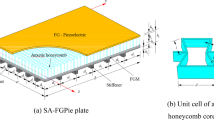Abstract
Correlating damage level and changes in dynamic characteristics of a structure forms the basis for damage detection techniques in structural health monitoring. In reinforced concrete building structures such correlation is not well established. A damage detection technique capable of identifying the structural condition of the system based on its small amplitude vibration response is desirable because such response is easier to obtain. It is a common practice in engineering applications to estimate dynamic parameters from small-amplitude vibrations assuming a linear behavior of the structure. This simplification causes inaccurate estimation of the dynamic properties in reinforced concrete structures due to the presence of nonlinear elastic behavior. In this study no such assumption is made and a linear model is only used for sets of data corresponding to the same displacement amplitude of a nonlinear elastic system. The trends found between small-amplitude vibration dynamic properties and past levels of maximum displacement in various reinforced concrete structures are reported. In addition to analytical and numerical studies, results from a series of laboratory tests are reported to demonstrate the use of the approach. One full-scale three-story reinforced concrete flat-plate building and six small-scale reinforced concrete beams were examined. In this study, small displacements are defined as displacements below an overall drift ratio of 0.03%. The displacement dependence of the dynamic properties is considered explicitly. It was found that while fundamental frequencies of the examined reinforced concrete specimens were found to decrease uniformly as past peak displacement level increased, the equivalent viscous damping ratio was found to increase until the past peak displacement reached the neighborhood of nominal yield displacement and then observed to decrease when the specimens are pushed beyond the nominal yield displacement level, which has not been reported in literature before. Recommendations are provided as to how small amplitude vibration tests should be set up to avoid misleading observations due to nonlinear response at small amplitude response, observations that could lead to erroneous conclusions regarding the damage state of a structure.













Similar content being viewed by others
References
American Concrete Institute [ACI] (2002) Building code requirements from structural concrete and commentary. ACI Committee 318, Farmington Hills
Bendat JS, Piersol AG (1986) Random data: analysis and measurement procedures. Wiley, New York
Bousman WG, Winkler DJ (1981) Application of the moving-block analysis. Proceedings, AIAA/ASME/ASCE/AHS 22nd Structures, Structural Dynamics and Materials Conference, Atlanta, Georgia 755–763
Celebi M (1986) Comparison of damping in buildings under low-amplitude and strong motions. J Wind Eng Ind Aerod 59(2–3):309–323
Chang PC, Flatau A, Liu SC (2003) Review paper: structural health monitoring of civil infrastructure. Struct Health Monit 2(3):257–267
Clinton JF, Bradford SC, Heaton TH, Favela J (2006) The observed wander of the natural frequencies in a structure. Bull Seismol Soc Am 96(1):237–257
Clough RW, Penzien J (1975) Dynamics of structures. McGraw-Hill, New York
Cohen L (1995) Time-frequency analysis. Prentice-Hall, Englewood Cliffs
Consuegra F (2009) On the relationship between small amplitude vibration dynamic properties and the past maximum displacement in reinforced concrete structures, PhD Thesis, School of Civil Engineering, Purdue University
Doebling SW, Farrar CR, Prime MB (1998) Summary review of vibration-based damage identification methods. Shock Vib Digest 30(2):91–105
Doebling SW (1996) Damage identification and health monitoring of structural and mechanical systems from changes in their vibration characteristics: a literature review. Los Alamos Laboratory, New Mexico
Farrar CR, Doebling SW, Nix DA (2001) Vibration-based structural damage identification. Phil Trans Roy Soc Lond A 359:131–149
Feldman M (2007) Considering high harmonics for identification of non-linear systems by Hilbert transform. Mech Syst Signal Process 21(2):943–958
Feldman M (1994) Non-linear system vibration analysis using Hilbert transform-I, Free Vibration Analysis Method ‘FREEVIB’. Mech Syst Signal Process 8(2):119–127
Fick D (2008) Experimental investigation and analytical modeling of the nonlinear response of flat-plate structures subjected to cycling loading failure. PhD Thesis, School of Civil Engineering, Purdue University
Galambos TV, Mayes RL (1978) Dynamic tests of a reinforced concrete building. Report, Washington University
Huang NE, Shen Z, Long ST, Wu MC, Shih HH, Zheng Q, Yen N, Tung CC, Liu HH (1996) The empirical mode decomposition and the Hilbert Spectrum for nonlinear and non-stationary time series analysis. Proc R Soc London, Ser A 454:903–995
Jeary AP (1997) Damping in structures. J Wind Eng Ind Aerod 72(1–3):345–355
The MathWorks, Matlab (2010) The language of technical computing. R2010A
Neild SA, Williams MS, McFadden PD (2003) Nonlinear vibration characteristics of damaged concrete beams. J Struct Eng, ASCE, 129: 2(260).
Oppenheim AV, Schafer RW, Buck JR (1999) Discrete-time signal processing. Prentice Hall
Priestley MJN (1998) Brief comments on elastic flexibility of reinforced concrete frames and significance to seismic design. Bull New Zeal Soc Earthquake Eng 31(4):246–259
Pugno N, Surace C (2000) Evaluation of the nonlinear dynamic response to harmonic excitation of a beam with several breathing cracks. J Sound Vib 235(5):749–762
Salawu OS (1997) Detection of structural damage through changes in frequency: a review. Eng Struct 19(9):718–723
Takeda T, Sozen M, Nielsen NN (1970) Reinforced concrete response to simulated earthquakes. J Struct Div, Proc Am Soc Civ Eng
Trifunac MD (1972) Comparison between ambient and forced vibration experiments. Earthquake Eng Struct Dynam 1:133–150
Worden K, Farrar CR, Haywood J, Tood M (2008) A review of nonlinear dynamic applications to structural health monitoring. Struct Contr Health Monit 15:540–567
Wu Z, Liu H, Liu L, Yuan D (2007) Identification of nonlinear viscous damping and Coulomb friction from the free response data. J Sound Vib 304(1–2):407–414
Author information
Authors and Affiliations
Corresponding author
Rights and permissions
About this article
Cite this article
Consuegra, F., Irfanoglu, A. Variation of Small Amplitude Vibration Dynamic Properties with Displacement in Reinforced Concrete Structures. Exp Mech 52, 817–828 (2012). https://doi.org/10.1007/s11340-011-9590-0
Received:
Accepted:
Published:
Issue Date:
DOI: https://doi.org/10.1007/s11340-011-9590-0




